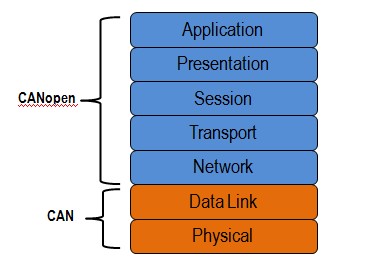The CANopen over EtherCAT (CoE) protocol allows devices equipped with CANopen to be used on EtherCAT-based Industrial Ethernet networks.
CANopen: Simple and low-cost
CANopen is a communication protocol based on the CAN (Controller Area Network) physical communication standard. In the OSI communication model, CAN specifies the physical and data link layers, while CANopen addresses the higher layers — network, transport, session, presentation, and application.

Image credit: National Instruments
The CANopen protocol defines how automation devices are configured and accessed, and how messages are exchanged between them. CANopen is object-based, meaning that each node (drives, controllers, encoders, I/O, and other devices) in the network has an object dictionary, which contains communication objects. These communication objects cover acyclic configuration data, which is handled by Service Data Objects (SDOs); cyclic real-time data, which is handled by Process Data Objects (PDOs); network management data; and special functions.
The use of object dictionaries, Service Data Objects, and Process Data Objects is a key component of the CANopen protocol, with SDOs being the mechanism for read-write access to the object dictionary.
CANopen is widely used thanks to its low hardware cost, wide range of device and application profiles, and simple implementation. It’s also extremely reliable and provides real-time communication, making it suitable for industrial applications.
EtherCAT: Fast and deterministic
EtherCAT is an Industrial Ethernet network. It’s based on standard Ethernet hardware but uses a “processing-on-the-fly” method for transporting and routing messages. In addition to being a real-time networking protocol, EtherCAT is deterministic, meaning it guarantees that a message will be transmitted (or an event will occur) in a specified, predictable period of time — not slower or faster.
EtherCAT allows up to 100 meters between nodes (devices) and can provide data transmission rates up to 100 Mbps, with cycle times of less than 100 μs and extremely low jitter, thanks to distributed synchronized clocks.

Image credit: IEB Media
CANopen over EtherCAT: Implementing CANopen devices on Industrial Ethernet
CANopen over EtherCAT (CoE) allows the CANopen communication protocol to be implemented over an EtherCAT network, providing a user-friendly, cost-effective solution that provides deterministic data delivery along with faster transmission speeds over longer network lengths.
The use of CANopen over EtherCAT is possible in signifiant part because EtherCAT implements the same communication system, including object dictionaries, SDOs (the SDO protocol is implemented directly from CANopen, without changes) and PDOs. And on an EtherCAT network, PDO frames are sent deterministically and without the 8-byte limit imposed by CANopen. CANopen over EtherCAT also supports the CANopen device profiles, which specify the parameters and behavior of the device, as well as the device class-specific state machines.

Image credit: Applied Motion Products







Leave a Reply
You must be logged in to post a comment.